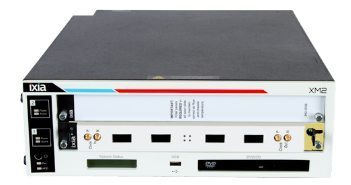Ixia announced what it claims to be the first 400 gigabit per second test solution for Ethernet networks, positioning itself at the front of the curve for supporting the development of next-generation wireline networks.
The demands for those ever-faster wireline networks are being driven in large part by the needs of wireless, according to Thananya Baldwin, senior director of strategic programs at Ixia Labs, which developed the test solution.
Ixia has already completed the a 400 GbE interoperability test with networking platform company Ciena, using the new 400GbE JumpStart Test system.
Ixia has been deeply involved in the standards development process for the last several rounds of wireline networks, Baldwin added, from the development of 40G and 100G standards back in the 2008 timeframe to the new 802.3bs standard being developed for 400G. Ixia is now on its third generation of 100G equipment, she noted, and sees widespread use of 40G in addition to some 100G deployments.
However, before those technologies could be put into the field, significant development work was going on four to six years ago and Ixia wants to be at the forefront of ecosystem development for 400G, Baldwin said. She said that transport companies have usually been the first to be interested in next-generation network speeds, followed by optics companies, and then the carriers themselves as the equipment develops to the point that it can be deployed in their networks.
“We are thinking about the next speed. We’re getting ready, so that when our transport customers and optics customers and the carriers start thinking about 400G, they can come to us and discuss the challenges of development or testing the new speeds, and we’re there for them, ahead of them,” Baldwin said.
The new proof-of-concept test solution can transmit wire rate packet generation at 400 Gbps, or 600 million packets per second. Ixia said that level of speed would be fast enough for 50,000 simultaneous high-definition video streams from Netflix.
“They’ve never seen this kind of traffic, this fast and this furious,” Baldwin said, adding that the ability to generate that much traffic sets the stage for determining whether, and how well, a network handles that amount of data and where the architectural weak points are.
Other test vendors also have their sights set on 400G. Tektronix acquired privately-held Picosecond Pulse Labs, based in Boulder, Colo., in January, with the purchase “intended to strengthen the Tektronix portfolio in the growing market for test equipment to support 100G/400G optical data communications research and development.”
Last spring, Tektronix also released a software update for automated test support for 400 Gbps, multi-carrier coherent optical modulation. Research on 400G transport networks is being driven largely by mobile traffic and cloud computing, according to Brian Reich, GM of performance oscilloscopes for Tektronix.
In addition, EXFO launched a 400G testing solution last fall with the ability to configure up to four 100 Gbit/s interfaces simultaneously and simulate real-life services in order to monitor QoS metrics to validate implementations.

Ixia moves forward with 400G test solution
ABOUT AUTHOR
